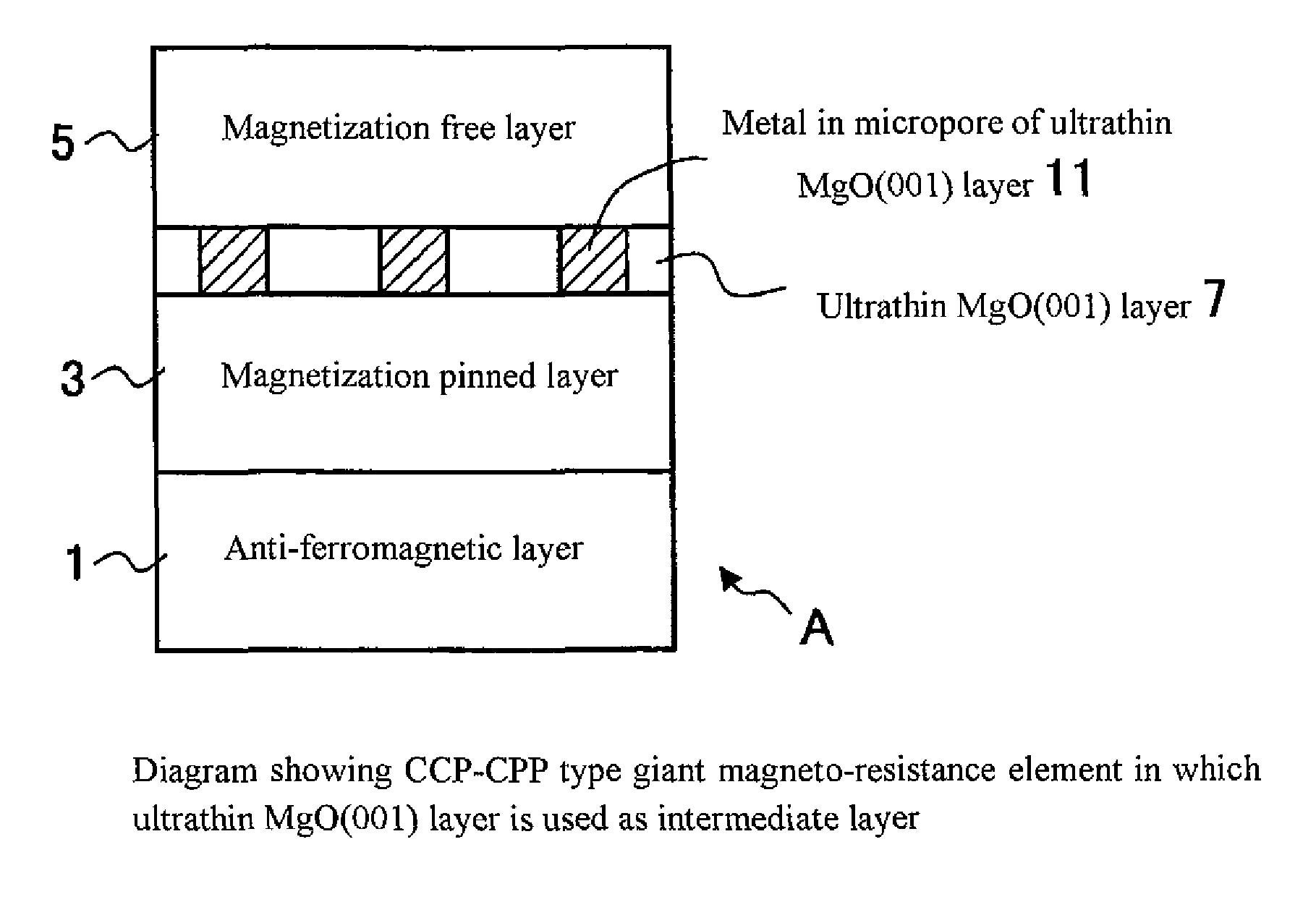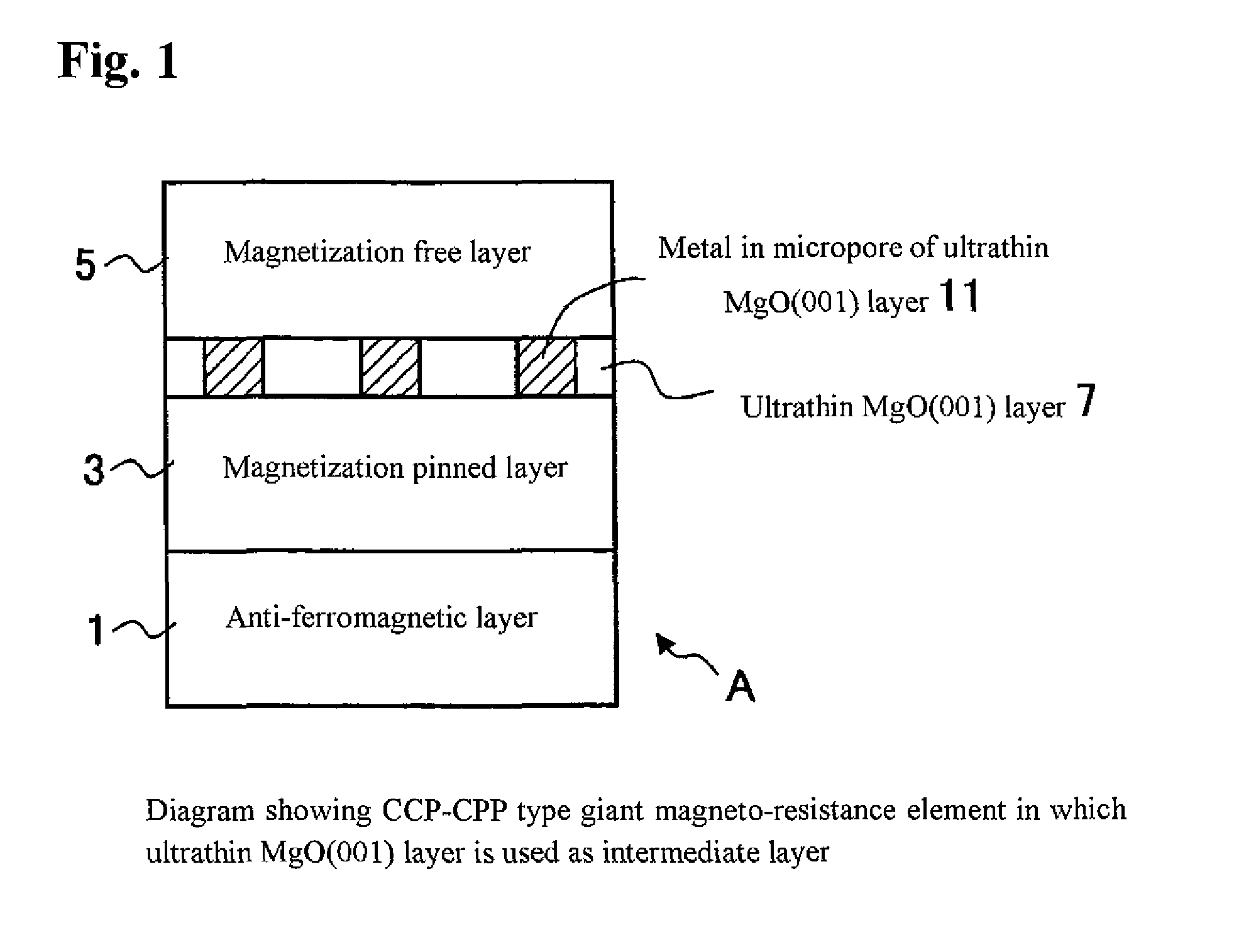Cpp type giant magneto-resistance element and magnetic sensor
a technology of giant magnetoresistance and magnetic sensor, which is applied in the direction of magnetic bodies, instruments, transportation and packaging, etc., can solve the problems of affecting the magnetic recording density, and difficult to increase the mr ratio, etc., to achieve high mr ratio, low resistance, and high mr ratio
- Summary
- Abstract
- Description
- Claims
- Application Information
AI Technical Summary
Benefits of technology
Problems solved by technology
Method used
Image
Examples
first exemplary embodiment
[0056]With reference to FIG. 6 to FIG. 12 and Table 1, the exemplary embodiments will be described. First, the present inventors' conception, experimental techniques and experimental results will be described. The inventors studied the spin filter effect by a single-crystal barrier, which is known in an MR element as a TMR element using an MgO barrier, and conceived causing the current confining effect to come into play by using an ultrathin single-crystal barrier, which is an MgO barrier whose thickness is reduced to a limit as the intermediate layer.
[0057]First, a description will be given of an increase in MR by the current confining effect. In a CPP-GMR element, a related art technique involves confining a current path by interposing an ultrathin oxide layer in an interface between an intermediate layer and a magnetization pinned layer (or a magnetization free layer), thereby to improve the MR ratio (refer to, for example, H. Fukuzawa et al., IEEE-Mag. Vol. 40 (2004), pp. 2236)....
second exemplary embodiment
[0085]Next, the second exemplary embodiment will be described with reference to the drawings. FIG. 1 is a diagram that shows the construction of a CCP-CPP type MR element in the second exemplary embodiment. An MR element A has, as the intermediate layer, an ultrathin MgO(001) layer 7 having micropores with a thickness of not more than 1.0 nanometer. The MgO(001) layer used here refers to a magnesium oxide layer having a single-crystal structure whose crystal plane is oriented in the (001) direction (or a polycrystalline structure that is preferentially oriented in the (001) direction). When such a structure is used, the current confining effect is caused to come into play due to a metal 11 present in the micropores in the MgO(001) layer 7 and, therefore, the MR ratio increases. The structure of a spin valve type MR element in which an anti-ferromagnetic layer 1 is caused to be in close vicinity of a magnetization pinned layer 3 is adopted. However, it is not always necessary that th...
third exemplary embodiment
[0090]Next, the third exemplary embodiment will be described. FIG. 2 is a diagram that shows an example of the construction of a CCP-CPP type MR element in the third exemplary embodiment. This MR element in the third exemplary embodiment is such that in the MR element A of the second exemplary embodiment, a ferromagnetic material having a bcc (001) structure is used in a magnetization pinned layer 3a. Other features of the construction are the same as shown in FIG. 1. By adopting the above-described structure, the crystallizability and flatness of the MgO (001) layer are further improved and the MR resistance ratio increases further.
PUM
 Login to View More
Login to View More Abstract
Description
Claims
Application Information
 Login to View More
Login to View More - R&D
- Intellectual Property
- Life Sciences
- Materials
- Tech Scout
- Unparalleled Data Quality
- Higher Quality Content
- 60% Fewer Hallucinations
Browse by: Latest US Patents, China's latest patents, Technical Efficacy Thesaurus, Application Domain, Technology Topic, Popular Technical Reports.
© 2025 PatSnap. All rights reserved.Legal|Privacy policy|Modern Slavery Act Transparency Statement|Sitemap|About US| Contact US: help@patsnap.com



